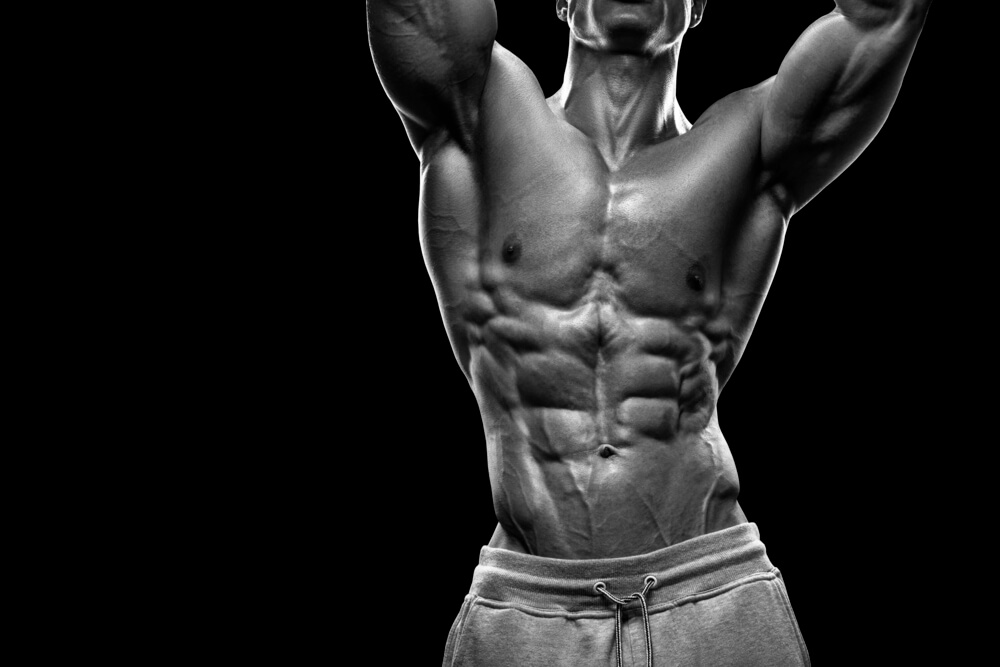
Want to know how to build muscle without fat? Get in line. Almost every person in the gym does. You need to be focused and realistic. We’ve got the info to help you succeed.
Sometimes there can be a fine line between gaining muscle and gaining fat. You want to bulk up so you eat the things that you should be eating to do that – lots of carbs and lots of proteins. But sometimes as you’re gaining muscle, you start to notice a small amount of fat being gained as well. So, while you are busting your butt at the gym and sticking to your healthy diet, the layer of fat building up over your washboard is ruining your muscle gains. That’s why we have crafted a plan on how to gain muscle while leaving that fat in the past.
Why Does Muscle Come With Fat?
What is it that makes us gain fat when we are actually trying to gain muscle?
Well, there are a couple reasons. The first reason might be a flaw in your plan. Maybe your diet wasn’t quite what your body needed or maybe you just did not work out as hard as you should have.
The second reason is a little more complicated. What you need to be focusing on is a caloric surplus. A caloric surplus is what exists when you consume more calories than your body needs to maintain its current state.
For example, if your body needs 2,000 to maintain itself and you consume less than 2,000 calories a day, then you would put yourself into a caloric deficit. This, of course, is one of the main things to do when you are trying to lose fat. But, when trying to bulk up, you should be consuming more than 2,000 calories. That would put you into a surplus, which is what you need to build muscle.
When you consume more calories than your body knows what to do with, it will store them in one of two ways. Your body will either store them as fat for energy, or it will store them in your muscle tissue. To gain new muscle tissue, your body needs a surplus of energy. It will also help support the muscles and assist damaged muscles to recover.
When you have a surplus of calories, you have something called calorie partitioning. Calorie partitioning is also called nutrient partitioning. This refers to where the extra calories and nutrients will go. It also refers to where your body will get energy when it needs it (so either stored body fat or muscle tissue). However, there are three general places that calories go. They go either towards new muscles, towards new body fat or both.
Main Factors Involved To Build Muscle Without Fat
Why?
Well there are some factors that you just can’t control no matter what you do and how hard you try.
First among them is genetics. Unfortunately, you are unable to change your genetics. Genetics affect thyroid levels, insulin sensitivity, muscle fiber types, muscle lengths, bone structure, joint size, recovery capabilities, volume tolerance, work capacity and more. If you have above-average genetics, then your surplus of calories will go towards muscles and less towards fat. An average person should expect something in between.
Second, there is age. The muscle to fat ratio will be much better for someone who is younger than someone who is older. Obviously, a 25-year-old has the ability to be much more physically fit than a 45-year-old (if they want to be).
Third, there is gender. Men are generally (but not always) able to build a lot more muscle and do it faster than women just because they are hormonally and structurally better suited for it. This translates into the fact that men are better than women at turning their excess calories into muscle instead of fat.
Do not let these factors scare you. There are plenty of factors that you can control and that influence your calorie partitioning. These include your body fat percentage, your rate of weight gain, your calorie intake, your protein, fat and carb intake, your meal frequency, your eating style, your training program, your cardio program and your lifestyle.

This Is Where The Calories Factor In
What you need to do is maximize lean muscle and minimize body fat. You can do this by optimizing each and every one of those things we just said. You can do this maintaining a moderate calorie surplus of 5 to 10% when bulking. For men, this should allow you to gain 0.5 to 1 pound per week. For women, you should aim for 0.25 to 0.5 pounds a week.
Be sure not to mess it all up during cheat meals. Yes, it is important to enjoy a great meal and splurge a little bit. But do not throw it all down then drain for one meal. Be smart. And let’s try and stay away from cheat days. Keep it to a cheat meal. That means one!
You might also be surprised to know how many calories are in meals at restaurants. A study done at Tufts University looked at 360 dinner entrees at 123 non-chain restaurants in San Francisco, Boston, and Little Rock. They found that restaurant dishes contained 1,200 calories on average.
You need to lose fat first. So if you’re a man with over 15% body fat, then you need to take it down to 10% before bulking. If you are woman with over 25% body fat, then you need to take it down to 20% body fat before bulking. In doing this, you preserve insulin sensitivity and hormonal balance, you can maintain calorie surplus for months before having to reduce body fat levels and it will save you lots of grueling cuts.

Not Gaining Weight (Get The Right Combo)
You may come across the problem of not gaining any weight. Well, to sum it up, if this happens, then you have to eat more. But you have to eat the right things. We are not talking about eating fast food.
Make sure to keep your protein at 1 gram per pound of body weight. Increase your daily calorie intake by 100 to 150 by increasing carb intake. This means adding 25 to 35 carbs to your daily intake. If after a week to 10 days you do not notice any weight gain, then keep steadily increasing your calorie intake – specifically your carbs.
Carbs are the primary source of energy for our bodies. You will want to stick to complex carbs. They take longer for your body to burn and will therefore, give your body a lot more energy over a longer period of time. Plus it will prevent fat storage. When you consume carbs, those carbs turn into glucose, which enables contraction.
Consuming the right amount of carbs allows you to do heavy and intense weight training that will lead to muscle gain. As well, consuming carbs allows for better brain functioning. This boosts your mood and your mental ability. Your muscles also look bigger when your body stores water and glycogen in the muscle cells – so you’ll look super swoll. Consuming carbs also keeps your body from going into a catabolic state where it starts burning muscle tissue instead of fat or stored energy.

Micro And Macro Action Plan
You are never going to be in the best shape of your life if you don’t have the right nutrition plan to follow. Eating correctly is half the battle. A good place to start is counting your macros or macronutrients. All calories are derived from macronutrients. Meanwhile, things like minerals, vitamins and sodium are all micronutrients. These do not have calories.
Each macronutrient has a specific number of calories. One gram of protein has 4 calories. A gram of carbs has 4 calories. Meanwhile, a single gram of fat checks in with the highest macro calorie count of 9. Your body needs proteins, carbs and fats to function.
Carbs fuel your body. They give you fiber and lots and lots of energy. Carbs are broken down into two different types: Simple and complex carbohydrates. They are classified based on how quickly they break down and the sugar is absorbed.
Proteins help repair and build your blood, skin, cartilage and bones. If you do not give your body the protein it needs, you won’t be able to build your muscles to their fullest. A 2008 study published in the American Journal of Clinical Nutrition, found that people who ate higher-protein diets burn more calories in a day than those who were on diets with lower protein levels. As well, they found that those on higher-protein diets retained lean muscle mass while also losing weight.
Fat is something that tends to scare people. It shouldn’t. You just have to accept that there are good fats and bad fats.
Which are bad?
That would be the trans fats. The good fats are the saturated fats. Saturated fats are butter, high-fat cheese and high-fat meats like lamb, beef, and pork. Trans fats are usually in fried and packaged foods like baked goods, margarine, and baked goods. Unsaturated fats are the good fats. These are vital for improving your joint and bone health. They also work to lower blood pressure, protect against memory loss and lower your cholesterol.
Monounsaturated fats replace the bad fats. These are found in peanut butter, olive oil and avocados. Polyunsaturated fats can really do wonders for the health of your heart. They are found in foods like walnuts, tuna, salmon and corn oil.
To build muscle without fat, try to aim for a macronutrient ratio of 40% proteins, 40% carbs, and 20% fats. Your nutrition plan should consist of eating four to seven times a day with two to three hours in between each meal. This way, you will never be hungry and you can easily maintain an anabolic state (or building muscle).
This Is A Sample Diet
What follows is a good nutrition plan example based on a 3,000-calorie diet. This uses the 40% proteins, 40% carbs, and 20% fats ratio. However, be sure to remember that it is your body. You know what your body needs and wants. Make sure to adjust based on your own personal needs to get the best result.
Meal 1 – Breakfast
300ml of skimmed milk & 1 scoop (25g) of whey protein
80g of oats
1 egg and 3 egg whites
Snack 1
1 scoop (25g) of whey protein
20g of almonds
1 apple
Meal 2 – Lunch
150g cooked brown rice
150g of lean steak (5% of fat)
50g of broccoli
Snack 2
2 slices of whole wheat bread
50g of peanut butter
200ml of skimmed milk
Pre-Workout
1 scoop (25g) of whey protein
40g of oats
1 banana
Post-Workout
2 scoop (50g) of whey protein
1 banana
Meal 3 – Dinner
200g of chicken
150g of green beans
1 sweet potato
Snack 3 – Before Sleep
1 scoop (25g) of whey protein or casein
150ml of skimmed milk
20g of oats

Conclusion
So you want to know how to build muscle without fat?
That just isn’t a realistic goal. You need to be consuming more calories than normal and that means you’ll also be gaining a little fat along with muscle mass. It’s natural. But with the right nutrition plan and an even better fitness plan, you will be in top shape in no time at all.
Just remember that you know your body better than anyone. Do not be afraid to try different things to see what works and what does not work. You have plenty of time to have the body of your dreams so there is no rush. Take your time. It is just as much about the journey as it is about the destination. You will learn so much about yourself through this fitness journey and you’ll be thrilled when you see the result.
Stay focused!
By Sarah Bayard
Latest posts by Sarah Bayard (see all)
- How Much Cardio Should I Do? - Jul 25, 2016
- Eat And Train According To Your Body Type - Jul 1, 2016
- How To Build Muscle Without Fat - Jun 24, 2016









Sometimes there can be a fine line between gaining muscle and gaining fat. You want to bulk up so you eat the things that you should be eating to do that lots of carbs and lots of proteins.
[…] Source: Here […]
[…] Source: Here […]